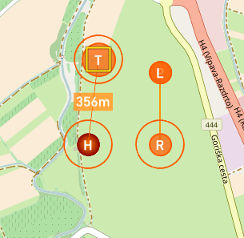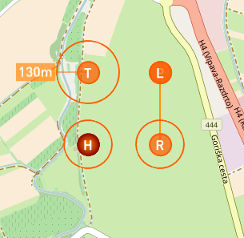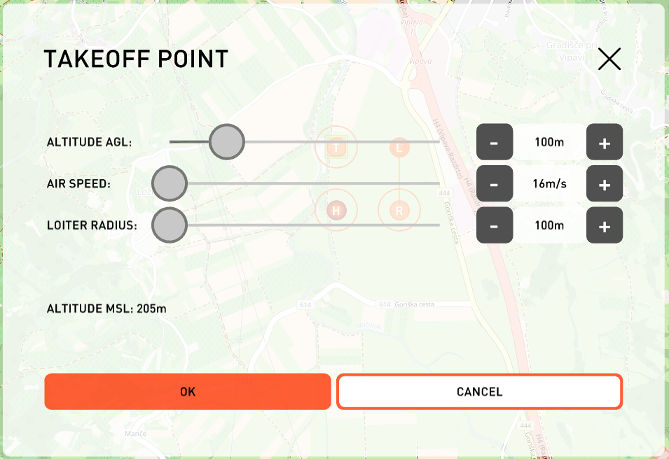
Take-off position is the location to which the UAV flies after the launch.
 Take-off |
Take-off point altitude is a value from a range between 100 m and 200 m above Home (launch) mean sea level (MSL) altitude. This insures that the UAV will always take-off upwards. If Take-off point altitude above ground level (AGL) becomes too low Ground proximity warning markers will appear around the point. Take-off point is removed from the map once the UAV changes flying mode from Take-off mode to some other mode (Navigation mode, Home mode etc.). |
 Take-off - Move the marker to change T point position. |
Click on Take-off point and move it to the desired position or place Take-off point through the context menu. Once the communication between C³P and the UAV is established the change of Take-off point position will trigger Upload Waypoints button to start blinking. After Upload Waypoints button is pressed new Take-off position will be uploaded to the UAV. |
 Take-off - change loiter radius. |
Select the circle around Take-off point and drag it to change its radius. Once the communication between C³P and the UAV is established the change of radius will trigger Upload Waypoints button to start blinking. After Upload Waypoints button is pressed new loiter radius will be uploaded to the UAV. |
 Red circles on the take-off trajectory warn you about the uphill take-off. |
Notice red warning markers in case of take-off up the hill WARNING: It is not advisable to take-off uphill. Warning red markers appear on the line between launch and Take-off point if terrain is rising according to Digital Elevation model. |
Parameters
Double-click on the take-off point (or click the entry in the Flight Plan table) to open the settings dialog.
Take-off parameters are settings used by the autopilot in Take-off mode. These settings are uploaded with the flight plan using Upload Waypoints button. Adjust display units in Settings, Units tab.
 Take-off Dialog. |
NOTE: Take-off point dialog is not accessible after the take-off.
Parameter |
Value |
|---|---|
Altitude AGL |
Min: Conditioned with the requirement that Take-off point must be at least 80 m above Home point. Max: Conditioned with the requirement that Take-off point can be at the most 200 m above Home point. Default value for T point is 100 m above Home point. NOTE: Have in mind that 100 m HAL might not be 100 m AGL if terrain is uneven. |
Air speed |
Min: Value depends on the selected airframe. Max: 22 m/s |
Loiter radius |
Min: 100 m Max: 200 m |
Altitude MSL |
Mean sea level altitude of T point. |
Take-off parameters.
If Take-off point altitude above ground level (AGL) becomes too low Ground proximity warning markers will appear around the point
WARNING: Terrain elevation should be checked on a topographic map. In some cases, DEM does not have correct values or any values (when flying outside of the covered area) which can lead to an unsafe situation. If this is the case you should adjust altitudes of waypoints in Mission Settings/Waypoints dialogs according to the information from topographic map.
